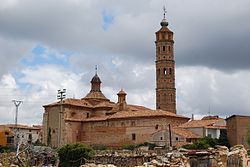Muniesa | |
|---|---|
 View of the main church in the village | |
 | |
| Coordinates: 41°02′N0°48′W / 41.033°N 0.800°W | |
| Country | Spain |
| Autonomous community | Aragon |
| Province | Teruel |
| Municipality | Muniesa |
| Area | |
• Total | 129.80 km2 (50.12 sq mi) |
| Elevation | 782 m (2,566 ft) |
| Population (2018) [1] | |
• Total | 599 |
| • Density | 4.6/km2 (12/sq mi) |
| Time zone | UTC+1 (CET) |
| • Summer (DST) | UTC+2 (CEST) |
| Website | /muniesa.org |
Muniesa is a municipality in the Teruel province of Aragon, Spain. In the 2017 INE census, its population is 630. [2]








